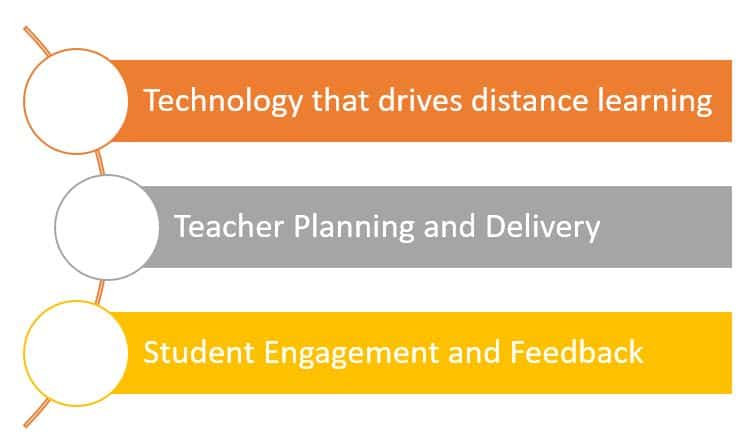
Today’s blog – What are the Best Practices Distance Education (learning), is a two-part blog that will help readers answer whether distance education actually works and how we can make learning for the user a success. This week’s blog sheds insight on how to improve distance education for the teacher and the student. Both of these blogs are co-written with Desiree Dixon, an expert in distance education, providing some insightful background information.
A picture is worth a thousand words…
Unless you want your session to look like the photo attached, you’d best consider what we are getting ready to share.
How Can We Take The Distance Out of “Distance Education?”
I am sure you have noticed the bare shelves at your local convenience, grocery, and drug stores. Everything from Clorox to toilet paper is gone!
Apple’s CEO, Tim Cook, announced closing its retail stores outside of the Greater China area until March 27, 2020. Bath and Body Works has followed suit.
Schools are shutting their doors.
No – it isn’t the zombie apocalypse. It is COVID-19—the coronavirus.
One little bug has changed the lives of global citizens, forcing us all to rethink how we commune and communicate. School leaders, CEOs, CIOs, and Chief Learning Officers (CLOs) must now consider alternative means of doing business, teaching, and learning. Technology has never had a better time to shine.
Distance learning is a great way for school districts to provide students with location independence while having a synchronous experience with their teacher. Critics cite a lack of direct contact and accountability, but there are ways to take the “distance” out of “distance education.”
If you recall last week’s blog, there are three main components to distance education.

How Can a Teacher (or Facilitator) Engage Distance Education to Their Audience?
- Use the Tools and insist that new tools are built to withstand the capacity necessary to enable technology to drive distance learning.
Not all students feel comfortable sharing publicly. This does not mean they are not active in the course. Most online environments offer valuable statistics.
Take advantage of these tools that most platforms offer:
- Track the number of times a video is viewed or a discussion is clicked.
- Access system reports that provide metrics and data to show login and engagement. These tools give us information on student habits. We can use this information to direct and redirect as needed.
- Use polls and surveys for conducting pulse checks and knowledge checks. These can be used upon entrance or exit as formative and informal assessments.
- Tapping into synchronous tools, such as text and video chat, are convenient ways to unpack challenging concepts in a group setting.
If there is a tool you know will make a difference in teaching and learning, we highly recommend that you request it from your supervisor, who will forward it to the company.
Use Your Teaching Skills with teacher planning and delivery
Teachers are constantly correcting grammar, considering differentiation techniques, and mulling over best practices. Classroom instructors are responsible for allowing students to interact with the content, supporting and clarifying misconceptions to meet objectives. We can do this by remembering to:
- Set and define objectives and expectations from the curriculum
- Involve and engage students by bridging prior knowledge
- Assist students in experiencing information relevant to objectives
- Provide related content assets and resources
- Give guidance, clarification, and feedback, assessing comprehension and performance application to check retention.
- Establish and maintain a safe learning climate
The secret here is to know your student (or employee).
Teach the way you would want to be taught!
Offer an environment conducive to learning. Classroom management practices are just as valuable online as they are face-to-face. Teachers establish and maintain a safe learning climate online by modeling expectations and setting the standard.
For example, sarcasm can never infiltrate the learning environment. One person’s joke can be another person’s mockery. Community-building practices should occur throughout the course, not just the first week. Group activities are a great way to build comradery among learners.
Take care not to single students out. Ask them, through private chat, if they would share exemplary work. Circulate through the roster and select new students each time until all students have been allowed to share.
Finally, be human. Admitting to being stumped and asking students if they have expertise on a topic is a great way to build confidence in students.
Use student’s talents when seeking engagement and feedback
Digital-aged students are experienced, accomplished, and proud. They have experienced life through social media, online gaming, athletics, and other extracurricular activities. Therefore, they bring these experiences and opinions into the classroom environment with them.
Allow them to process concepts through discussion and experimentation rather than listening passively. Provide expressive opportunities in the online classroom by using engagement tools, such as chat, whiteboard, and polls, to empower learners to apply the content to real-life situations in real time. Students will want and need to try out what they’ve learned in a simulated environment to get evidence of usefulness, and they crave feedback on their performance.
DISCLAIMER! – We’re about to vent, so you’d best skip this section if you don’t want an honest opinion.
What Else Should Someone Keep In Mind When Using Best Practices Distance Education?
We ALL have the attention span of a gnat.
Yep – called you out.
If you don’t believe me, see how long you will be engaged in your next faculty or department meeting while your boss preaches.
We even dare you to time yourself and see how long you remain focused.
So don’t you even think that a student, much less an employee, will remain on task during the lesson?
You better make your first impression on the platform a good one.
If you don’t – kiss that experience goodbye!
Lastly-
Don’t you dare do this if you’re a buyer or supervisor!
Before you think about purchasing any platform, we strongly recommend that the supervisor not only see it but use it. Don’t take the vendor’s word, as they will provide you with the best parts of the product.
As distance education becomes increasingly popular, it is essential for the C-Suite or Central Office officials to “practice what they preach.”
Nothing will make a facilitator angrier than to get a tool for work with no input, much less something that isn’t vetted by the supervisor who tried it.
When supervisors and purchasers participate in the decision process, the buyers won’t be asking for details, much less trying to find the cheaper alternative to the platform you want.
If you are a supervisor, I would expect you to participate in the tutorial, ask for an ordinary lesson, watch it, and engage with the facilitator.
Last, create and integrate experiences into the platform before considering purchasing it.
That’s a Wrap
We are at an advantage. Our learners communicate through social media every day. We cannot be afraid to bring the learning to where they feel comfortable—online.
Contact us if you want to change the way we view education. Leave a comment below or contact us So we can provide you with a laser-focused approach to building a better, more sophisticated teaching model.
[wp-faq-schema title=”Things to remember about distance education” accordion=1]
Check out our tool page to find ways to make your work smarter.



